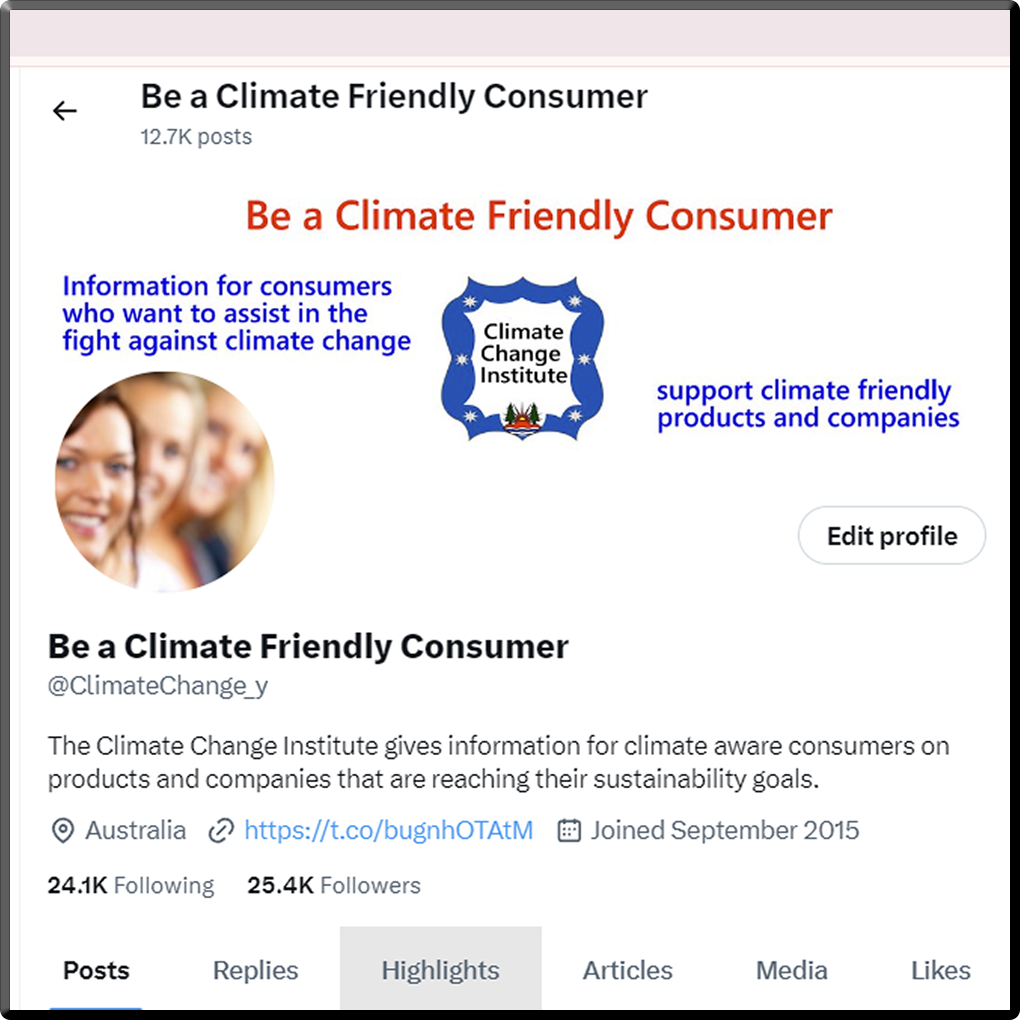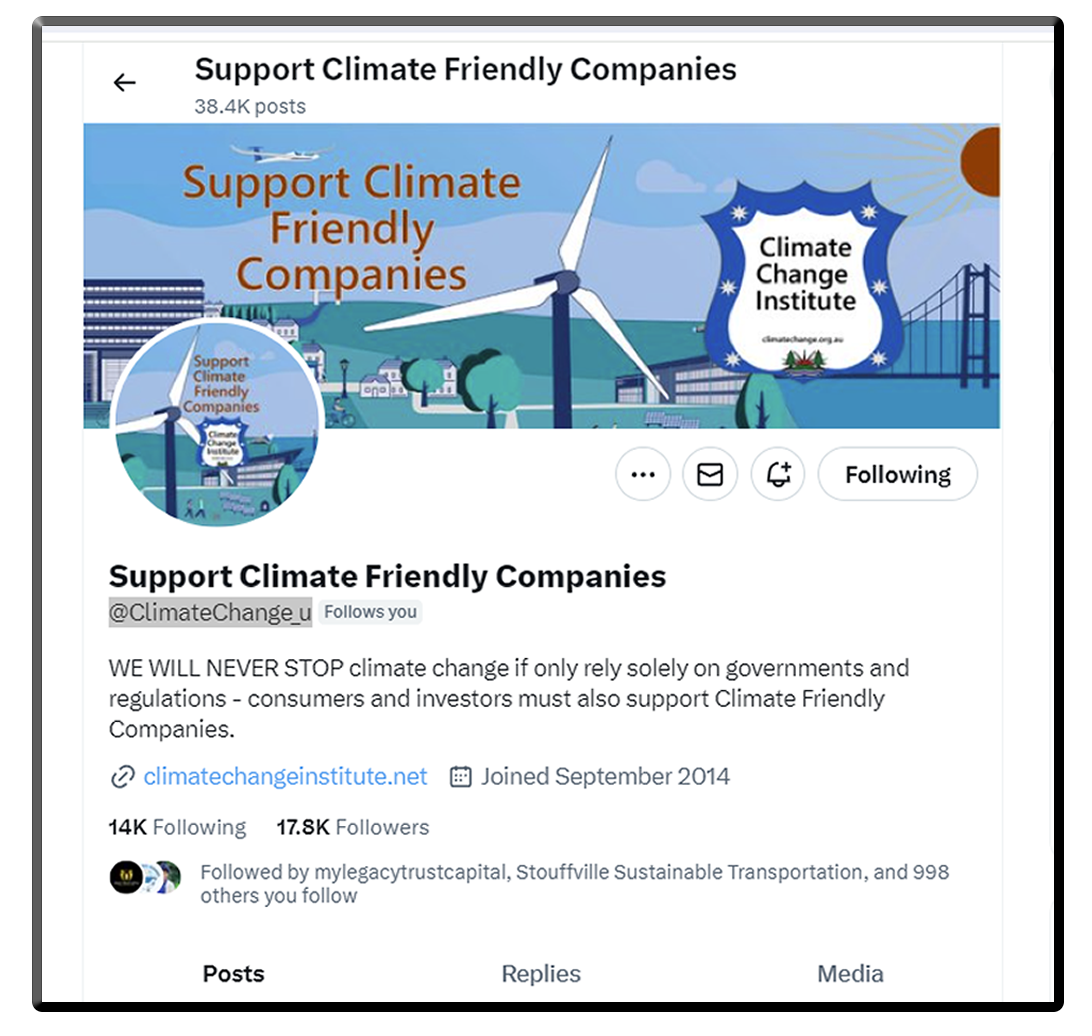We will never stop climate change if we rely solely on government regulations.
Many consumers are aware of this and want make climate friendly buying choices.

Our ‘Climate Friendly Consumer ’ x (Twitter) site is a popular source of information for consumers that are concerned about climate change.

The Institute also conducts an ongoing review for consumers to see which companies that are genuinely meeting their sustainability goals.
How can we be climate friendly?
There are many ways to reduce emissions and save energy, such as insulating your home or putting up solar panels. However we still need to make everyday changes to our lives to keep recusing our emission as far as possible.

1. Eat low on the food chain. This means eating mostly fruits, veggies, grains, and beans. Livestock—meat and dairy—is responsible for 14.5 percent of manmade global greenhouse gas emissions, mainly from feed production and processing and the methane (25 times more potent than CO2 at trapping heat in the atmosphere over 100 years) that beef and sheep belch out. Every day that you forgo meat and dairy, you can reduce your carbon footprint by 8 pounds—that’s 2,920 pounds a year. You can start by joining Meatless Mondays.
2. Choose organic and local foods that are in season. Transporting food from far away, whether by truck, ship, rail or plane, uses fossil fuels for fuel and for cooling to keep foods in transit from spoiling.
3. Buy foodstuffs in bulk when possible using your own reusable container.
4. Reduce your food waste by planning meals ahead of time, freezing the excess and reusing leftovers.
5. Compost your food waste if possible.

Clothing
6. Don’t buy fast fashion. Trendy, cheap items that go out of style quickly get dumped in landfills where they produce methane as they decompose. Currently, the average American discards about 80 pounds of clothing each year, 85 percent of which ends up in landfills. In addition, most fast fashion comes from China and Bangladesh, so shipping it to the U.S. requires the use of fossil fuels. Instead, buy quality clothing that will last.
7. Even better, buy vintage or recycled clothing at consignment shops.
8. Wash your clothing in cold water. The enzymes in cold water detergent are designed to clean better in cold water. Doing two loads of laundry weekly in cold water instead of hot or warm water can save up to 500 pounds of carbon dioxide each year.

Shopping
9. Buy less stuff! And buy used or recycled items whenever possible.
10. Bring your own reusable bag when you shop.
11. Try to avoid items with excess packaging.
12. If you’re in the market for a new computer, opt for a laptop instead of a desktop. Laptops require less energy to charge and operate than desktops.
13. If shopping for appliances, lighting, office equipment or electronics, look for Energy Star products, which are certified to be more energy efficient.
14. Support and buy from companies that are environmentally responsible and sustainable.

Home
15. Do an energy audit of your home. This will show how you use or waste energy and help identify ways to be more energy efficient.
16. Change incandescent light bulbs (which waste 90 percent of their energy as heat) to light emitting diodes (LEDs). Though LEDs cost more, they use a quarter of the energy and last up to 25 times longer. They are also preferable to compact fluorescent lamp (CFL) bulbs, which emit 80 percent of their energy as heat and contain mercury.
17. Switch lights off when you leave the room and unplug your electronic devices when they are not in use.
18. Turn your water heater down to 120˚F. This can save about 550 pounds of CO2 a year.
19. Installing a low-flow showerhead to reduce hot water use can save 350 pounds of CO2. Taking shorter showers helps, too.
20. Lower your thermostat in winter and raise it in summer. Use less air conditioning in the summer; instead opt for fans, which require less electricity. And check out these other ways to beat the heat without air conditioning.
21. Sign up to get your electricity from clean energy through your local utility or a certified renewable energy provider. Green-e.org can help you find certified green energy providers.
Transportation
Because electricity increasingly comes from natural gas and renewable energy, transportation became the major source of U.S. CO2 emissions in 2017. An average car produces about five tons of CO2 each year (although this varies according to the type of car, its fuel efficiency and how it’s driven). Making changes in how you get around can significantly cut your carbon budget.
22. Drive less. Walk, take public transportation, carpool, rideshare or bike to your destination when possible. This not only reduces CO2 emissions, it also lessens traffic congestion and the idling of engines that accompanies it.
23. If you must drive, avoid unnecessary braking and acceleration. Some studies found that aggressive driving can result in 40 percent more fuel consumption than consistent, calm driving.
24. Take care of your car. Keeping your tires properly inflated can increase your fuel efficiency by three percent; and ensuring that your car is properly maintained can increase it by four percent. Remove any extra weight from the car.
25. When doing errands, try to combine them to reduce your driving.
26. Use traffic apps like Waze to help avoid getting stuck in traffic jams.
27. On longer trips, turn on the cruise control, which can save gas.
28. Use less air conditioning while you drive, even when the weather is hot.
29. Use E10 petrol fuel as overall, ethanol is considered to be better for the environment than traditional gasoline
30. If you’re shopping for a new car, consider purchasing a hybrid or electric vehicle. But do factor in the greenhouse gas emissions from the production of the car as well as its operation. Some electric vehicles are initially responsible for more emissions than internal combustion engine vehicles because of manufacturing impacts; but they make up for it after three years. This app rates cars based on their mileage, fuel type and emissions from both the production of the car and, if they are EVs, from generating the electricity to run them.
Businesses that look to the future are realising the inevitable transition to a low carbon economy with growing pressure from governments and consumers.
McCarthy
McCarthy is dedicated to sustainability in all its operations and builds net zero energy buildings that create as much renewable energy on site as they…Read More
Thyssen Krupp
The steel company is switching from coal to hydrogen power to purify iron ore, which will drastically cut carbon emissions. https://www.thyssenkrupp.com/en/company/sustainability Our understanding of sustainability…Read More
Central Concrete
The California cement company is transitioning to low-carbon cement mixes and turning carbon emissions from other organisations into an important ingredient in its own materials….Read More
Wilmott Dixon
The company offsets its carbon emissions by investing in global programs to reduce carbon. https://www.willmottdixon.co.uk/sustainability We have been a purpose based sustainable company since 1852….Read More
Turner Construction Company
Committed to being a green builder, Turner is cutting on-site construction greenhouse gas emissions and water consumption in half by 2030.Read More
Intel
The tech company has shown a commitment to sustainability and is also focused on water preservation and aims to reduce its per-unit water consumption. https://www.intel.com.au/content/www/au/en/environment/intel-and-the-environment.html…Read More
Adobe
Adobe has earned awards for its efforts to move to net zero energy and to create LED-certified offices and reduce water consumption by more than…Read More
IBM
Sustainability is at the core of IBM’s mission, and it leads the way with smart buildings and water resource management to reduce demand and support…Read More
The company relies on renewable energy and aims to be Carbon free by 2030. https://sustainability.google/ Carbon neutral since 2007.Carbon free by 2030. SUSTAINABLE WITH GOOGLE…Read More
Umicore
Named a top 10 company in the world for sustainability, Umicore recycles materials to recover more than 20 types of metals that can be reused….Read More
Philips
The company drastically increased its energy efficiency in manufacturing and creates innovative and award-winning green products. https://www.philips.com.au/a-w/about-philips/sustainability.html Healthy people, sustainable planet Sustainability is at the core…Read More
Unilever
Their Sustainable Living Plan aims to double the company’s business and half its environmental impact in 10 years. https://www.unilever.com.au/planet-and-society/ Planet & Society We’re a company…Read More
HP Inc.
The company revamped its products to make every item completely recyclable and runs e-waste recycling plants around the world. https://www.hp.com/us-en/hp-information/sustainable-impact.html We aim to be the…Read More
S.C. Johnson
The household product manufacturer replaced nearly all of its coal power with natural gas and cut millions of pounds of waste from manufacturing its products.Read More
Siemens
https://new.siemens.com/global/en/company/sustainability.html Our Sustainability report: strong results, continued acceleration We have achieved further progress towards meeting our sustainability ambitions. At our Capital Market Day in June…Read More
Patagonia
The outdoor company is committed to having at least 75% of its materials sourced from sustainable places, and it donates 1% of profits to groups…Read More
Walmart
Walmart stores use 100% renewable energy sources, and the company even cut ties with suppliers that had manufacturing or distribution practices that added to carbon…Read More
Hilton Hotels
The company has an aggressive program to cut its footprint in half by 2030 and increase its sourcing from local suppliers.Read More
Greyhound
Their entire fleet of busses use clean-burning fuel and avoids idling to cut carbon emissions. https://www.greyhound.com/en/discover-greyhound/going-green We’ve done a lot in recent years to reduce…Read More
American Airlines
The airline has made large efforts to move towards renewable energy; all of the electricity purchased at its DFW headquarters now comes from renewable sources….Read More
ANA Airlines
Named the world’s most sustainable airline, ANA was the first global airline to issue Green Bonds to offset carbon emission and raise money for eco-friendly…Read More
Hyatt
Under its 2020 environmental framework, Hyatt achieved its 25% per square meter greenhouse gas reduction goals early across its three regions and set sustainability goals…Read More
United Airlines
The airline invested more than $16 billion to replace all of its airplanes with more fuel-efficient models and looks to continually lower its carbon emissions….Read More
Disney
In December 2020, The Walt Disney Company announced ambitious 2030 Environmental Goals focused on achieving net zero greenhouse gas emissions for our direct operations, reducing waste, building…Read More
Valeo
Ranked as the 5th most sustainable French company in any industry, Valeo has invested millions in sustainability and creates innovative solutions to lower its cars’…Read More
Coca-Cola
The soda company is fiercely dedicated to sustainable agriculture and is working towards sustainably sourcing all key ingredients by 2020 and reducing its carbon footprint…Read More
Nutrien
The agricultural company encourages innovative practices from its farmers to create healthy soil and environmental sustainability. https://www.nutrien.com/sustainability/strategy/carbon-program Our 2030 commitment By the year 2030, we…Read More
Cargill
The company maps emissions to lower carbon output through the entire supply chain and has a goal to lower greenhouse gas emissions by 10% by…Read More
John Deere
The farming equipment company aims to recycle 85% of materials and reduce carbon emissions on 90% of new products to create sustainable inventory.Read More
Bell resources
Bell resources is an Australian company that is making an outstanding contribution to fighting climate change with innovative clean energy & electric vehicle charging under…Read More
